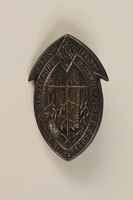Overview
- Brief Narrative
- German Worker's Union pin obtained during Zaro Calabrese's service in Europe in WWII.
- Credit Line
- United States Holocaust Memorial Museum Collection, Gift of Zaro Calabrese
- Contributor
-
Subject:
Zaro Calabrese
- Biography
-
Rosario "Zaro" Calabrese served as a member of the 3rd US Cavalry Group, which was attached to the 4th Armored Division of the US Army. The 4th Division landed at Utah Beach in Normandy on July 11, 1944 and entered combat in France. They played a significant role in the breakout from the Normandy beachhead and the liberation of France in 1944, and then fought their way through Germany. On April 4, 1945, they liberated Ohrdruf concentration camp, a subcamp of Buchenwald, the first concentration camp to be liberated by American troops. General Eisenhower visited the camp on April 12. When Germany surrendered on May 7, 1945, the Division was in Czechoslovakia. The 4th was placed on occupation duty until inactivated on April 26, 1946. Zaro settled in New Jersey.
Physical Details
- Language
- German
- Classification
-
Identifying Artifacts
- Category
-
Badges
- Object Type
-
Stickpins (lcsh)
- Physical Description
- Displaying a blue and gold tassel with gold letters "DOA" and black swastika on white background. The pin has separated from the clasp.
- Dimensions
- overall: Height: 1.120 inches (2.845 cm) | Width: 1.120 inches (2.845 cm) | Depth: 0.500 inches (1.27 cm)
- Materials
- overall : metal, enamel, paint
Rights & Restrictions
- Conditions on Access
- No restrictions on access
- Conditions on Use
- No restrictions on use
Administrative Notes
- Legal Status
- Permanent Collection
- Provenance
- The Nazi Party pin was donated to United States Holocaust Memorial Museum by Zaro Calabrese in 1995.
- Record last modified:
- 2023-08-31 10:37:45
- This page:
- https://collections.ushmm.org/search/catalog/irn9015
Download & Licensing
In-Person Research
- By Appointment
- Request 21 Days in Advance of Visit
- Plan a Research Visit
- Request to See This Object
Contact Us
Also in Zaro Calabrese collection
The collection consists of Nazi pins and badges acquired by Zaro Calabrese during his military service in Europe during World War II (1939- 1945).
Date: 1936-1945
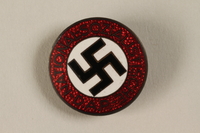
NSDAP membership badge found by Zaro Calabrese
Object
Nazi Party membership pin (Parteiabzeichen) obtained during Zaro Calabrese's service in Europe in WWII (1939-1945). All members of the Nazi Party wore these pins. They were typically worn on the lapels of their civilian clothing and some uniforms.
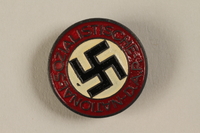
NSDAP membership badge found by Zaro Calabrese
Object
Nazi Party membership pin (Parteiabzeichen) obtained during Zaro Calabrese's service in Europe in WWII (1939-1945). All members of the Nazi Party wore these pins. They were typically worn on the lapels of their civilian clothing and some uniforms.
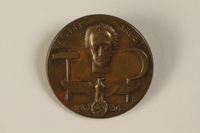
Nazi Party pin for Labor Day 1934 found by Zaro Calabrese
Object
Nazi Party Labor Day (Tag der Arbeit) 1934 pin obtained during Zaro Calabrese's service in Europe in WWII (1939-1945). Labor Day (also known as May Day) takes place on May 1 to celebrate laborers and the working classes. In April 1933, after the Nazi party took control of the German government, May 1 was appropriated as the “Day of National Work,” with all celebrations organized by the government. On May 2, the Nazi party banned all independent trade-unions, bringing them under state control of the German Labor Front. This style of mass-produced, cast metal pin is often referred to colloquially as a tinnie.
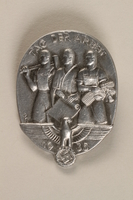
Nazi Party pin for Labor Day 1935 found by Zaro Calabrese
Object
Nazi Party Labor Day (Tag der Arbeit) 1935 pin obtained during Zaro Calabrese's service in Europe in WWII (1939-1945). Labor Day (also known as May Day) takes place on May 1 to celebrate laborers and the working classes. In April 1933, after the Nazi party took control of the German government, May 1 was appropriated as the “Day of National Work,” with all celebrations organized by the government. On May 2, the Nazi party banned all independent trade-unions, bringing them under state control of the German Labor Front. This style of mass-produced, cast metal pin is often referred to colloquially as a tinnie.
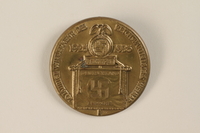
Nazi Party Congress badge from a rally in Weimar found by Zaro Calabrese
Object
Commemorative pin from a Nazi Party rally in Weimar, Germany, in July 1936. The rally marked the tenth anniversary of a Nazi Party Congress in Weimar in 1926. Before the Nazi Party came to national power in 1933, it held annual congresses such as the one in Weimar. This style of mass-produced, die-struck metal pin is often referred to colloquially as a tinnie.

Hitler Youth membership badge
Object
Button displaying the Nazi party insignia. Worn by all members most likely on the lapel and obtained during Zaro Calabrese's service in Europe in WWII.

Nazi Party SS badge for Social Member
Object
Button displaying the Nazi party insignia. Worn by all members most likely on the lapel and obtained during Zaro Calabrese's service in Europe in WWII. SS badge for Social Member [Foerdernde Mitglieder]

Nazi Party badge
Object
Button displaying the Nazi party insignia. Worn by all members most likely on the lapel and obtained during Zaro Calabrese's service in Europe in WWII.

Nazi Party badge
Object
Button displaying the Nazi party insignia. Possibly a Gauleiter badge. It was obtained during Zaro Calabrese's service in Europe in WWII.
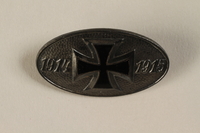
Iron Cross medal, World War I
Object
Pin of the German Army of World War I. It was obtained during Zaro Calabrese's service in Europe in WWII.
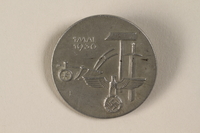
Nazi Party pin for Labor Day 1936 found by Zaro Calabrese
Object
Nazi Party Labor Day (Tag der Arbeit) 1936 pin acquired by Zaro Calabrese, an American soldier, in Europe during World War II (1939- 1945). Labor Day (also known as May Day) takes place on May 1 to celebrate laborers and the working classes. In April 1933, after the Nazi party took control of the German government, May 1 was appropriated as the “Day of National Work,” with all celebrations organized by the government. On May 2, the Nazi party banned all independent trade-unions, bringing them under state control of the German Labor Front. This style of mass-produced, die-struck metal pin is often referred to colloquially as a tinnie.
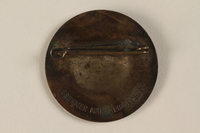
Commemorative pin for Martin Luther's Anniversary Day 1933
Object
It was obtained during Zaro Calabrese's service in Europe in WWII.
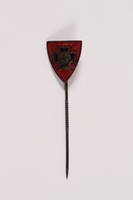
Nazi Party pin
Object
Pin displaying the Nazi party insignia; possibly a war service pin. It was obtained during Zaro Calabrese's service in Europe in WWII.
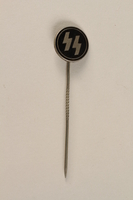
Nazi Party SS member stickpin
Object
Pin displaying the Nazi party insignia. It was obtained during Zaro Calabrese's service in Europe in WWII.

Nazi Party German Labor Front stickpin
Object
Pin displaying the Nazi party insignia. It was obtained during Zaro Calabrese's service in Europe in WWII.
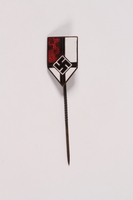
Nazi Party member stickpin
Object
Pin displaying the Nazi party insignia; it was possibly worn by a Gauleiter. It was obtained during Zaro Calabrese's service in Europe in WWII.

NSFK: Nazi Flying Corps pin
Object
Pin displaying the Nazi party insignia. It was obtained during Zaro Calabrese's service in Europe in WWII.
![SS badge for Social Member [Foerdernde Mitglieder] SS badge for Social Member [Foerdernde Mitglieder]](https://www.ushmm.org/media/emu/get?irn=9019&mm_irn=18222&file=secondary)
SS badge for Social Member [Foerdernde Mitglieder]
Object
Pin displaying the Nazi party insignia. It was obtained during Zaro Calabrese's service in Europe in WWII.
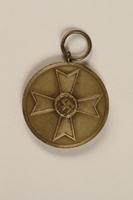
German civilian war service medallion
Object
War service medal awarded to civilians who performed with merit tasks connected with production of war materials. The ribbon was black with white side stripes and adjoining red edges; in center of ribbon was a narrow red stripe. It was obtained during Zaro Calabrese's service in Europe in WWII.
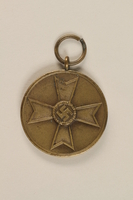
German civilian war service medallion
Object
War service medal awarded to civilians who performed with merit tasks connected with production of war materials. The ribbon was black with white side stripes and adjoining red edges; in center of ribbon was a narrow red stripe. It was obtained during Zaro Calabrese's service in Europe in WWII.

